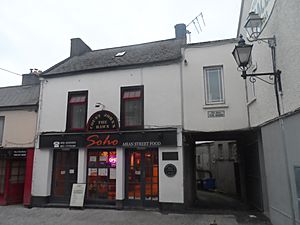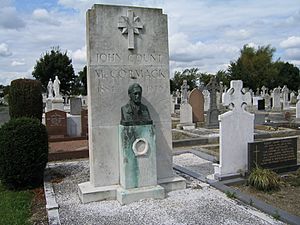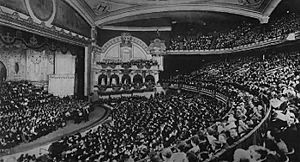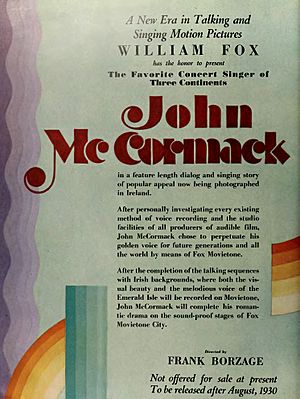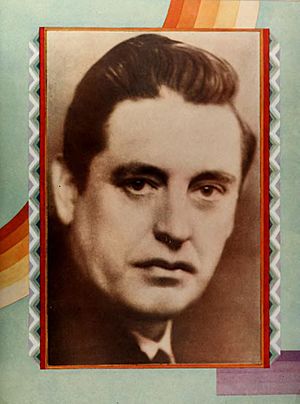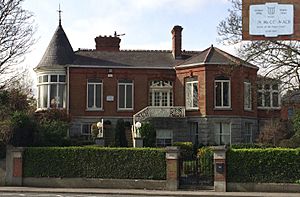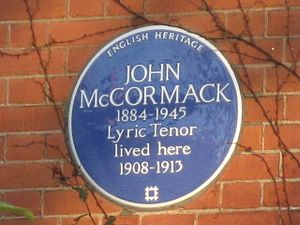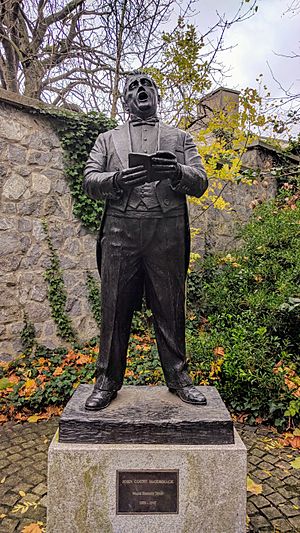John McCormack (tenor) facts for kids
Quick facts for kids
Papal Count
The Count McCormack
KSG, KSS, KHS
|
|
|---|---|
 |
|
| Born | 14 June 1884 Athlone, County Westmeath, Ireland |
| Died | 16 September 1945 (aged 61) Booterstown, Dublin, Ireland |
| Occupation |
|
| Citizenship |
|
| Spouse |
Lily Foley
(m. 1906) |
| Children | 2 - 1 son, 1 daughter |
John Francis McCormack (born June 14, 1884 – died September 16, 1945) was a famous Irish singer. He was known as a lyric tenor, which means he had a high, clear male singing voice. He was celebrated for singing both operatic songs and popular tunes. People especially admired how clearly he spoke the words (his diction) and how well he controlled his breath while singing. He was also given the special title of Papal Count by the Pope. John McCormack became an American citizen before moving back to live in Ireland.
Contents
John McCormack's Early Life and Family
John Francis McCormack was born on June 14, 1884, in Athlone, a town in County Westmeath, Ireland. He was the second son and fifth of 11 children in his family, though sadly, many of his siblings died young. His parents, Andrew McCormack and Hannah Watson, both worked at the Athlone Woollen Mills. John was baptized in St Mary's Church, Athlone.
He went to school with the Marist Brothers in Athlone and later attended Summerhill College in Sligo. John loved to sing from a young age and was part of the choir at St Peters church in Athlone. When his family moved to Dublin, he joined the choir at St Mary's Pro-Cathedral. There, a music teacher named Vincent O'Brien discovered his amazing talent. In 1903, John won a gold medal at the Dublin Feis Ceoil, a big music competition. He married Lily Foley in 1906, and they had two children, Cyril and Gwen.
McCormack's Singing Career
Thanks to people who helped raise money for him, John McCormack traveled to Milan, Italy, in 1905. There, he trained his voice with a teacher named Vincenzo Sabatini. Sabatini noticed that John's voice was naturally good. He focused on helping John perfect his breath control, which became one of the things he was most famous for as a singer.
In 1906, John McCormack performed in an opera for the first time in Savona, Italy. The next year, he had his first big opera performance at Covent Garden in London. He sang in an opera called Cavalleria rusticana and became the youngest main tenor (a type of male singer) at that famous theater. In 1909, he started his career in America. At this time, he was known for his Italian style of opera singing.
In 1911, he starred in a new opera called Natoma. Later that year, he toured Australia with the famous singer Dame Nellie Melba. By 1912, John McCormack started focusing more on concert performances, where he would sing for audiences without the full opera stage. His beautiful voice and charming personality made him the most celebrated lyric tenor of his time. He stopped performing in operas after 1923. He was famous for his amazing breath control; he could sing 64 notes on just one breath in a song from Mozart's Don Giovanni.
John McCormack made hundreds of recordings. His most popular records were made for the Victor Talking Machine Company in the 1910s and 1920s. He was one of their most successful recording artists. In the 1920s, he often sang on the radio. He also appeared in two movies: Song o' My Heart (1930), where he played an Irish tenor, and Wings of the Morning (1937), which was one of the first British movies made in full color.
He was one of the first singers to record the popular song "I Hear You Calling Me" and it became his best-selling record. He was also the first to record the famous World War I song "It's a Long Way to Tipperary" in 1914. He recorded another popular war song, "Keep The Home Fires Burning" in 1917. John McCormack also sang songs that showed his Irish pride, like "The Wearing of the Green". He often sang songs by Thomas Moore, such as "The Minstrel Boy" and "The Last Rose of Summer".
In 1917, John McCormack became a citizen of the United States. In 1918, he gave a lot of money to help with the USA's efforts during World War I. His career was very successful, and he earned millions of dollars from his record sales and performances.
From 1939 to 1943, Gerald Moore was John McCormack's piano accompanist. In 1927, McCormack moved into a large home called Moore Abbey in County Kildare, Ireland. He lived a very fancy lifestyle and also owned apartments in London and New York. He even owned racehorses, hoping one would win a big race, but none ever did.
In 1930, McCormack bought a large estate in Hollywood, California, called Runyon Canyon. He liked the place while filming Song o' My Heart there. He used the money he earned from the movie to buy the estate and built a mansion he named 'San Patrizio'. He and his wife lived there until 1938. When they were away touring, famous people like Janet Gaynor and Charles Boyer would sometimes rent their mansion. The McCormacks became friends with many Hollywood stars.
John McCormack officially ended his singing career with a concert in London in 1938. However, a year later, he started singing again to help the Red Cross and support the war effort during World War II. He gave concerts, toured, and recorded until 1943, when his health made him stop for good.
He became ill with emphysema, a lung condition. He bought a house near the sea called "Glena" in Booterstown, Dublin. After years of poor health and several illnesses, John McCormack passed away at his home on September 16, 1945. He is buried in Deans Grange Cemetery.
Honors and Legacy
John McCormack received many honors for his amazing musical career. In 1928, Pope Pius XI gave him the special title of Papal Count. This was to recognize his charity work for the Catholic Church. Before that, he had already received three special knighthood titles from the Pope: Knight of the Order of the Holy Sepulchre, Knight of the Order of St. Gregory the Great, and Knight of the Order of St. Sylvester. He was also a Knight of Malta.
One of his most famous performances in Ireland was when he sang César Franck's Panis angelicus to hundreds of thousands of people in Dublin's Phoenix Park during the 1932 Eucharistic Congress.
A life-sized bronze statue of John McCormack was put up in Dublin on June 19, 2008. It stands in the Iveagh Gardens, near the National Concert Hall. In his hometown of Athlone, the Athlone Institute of Technology named their performance hall the John McCormack Hall in his honor. There is also an English Heritage blue plaque on the house in London where he lived from 1908 to 1913.
In January 2014, the Central Bank of Ireland released a special silver €10 coin featuring a portrait of McCormack. In October 2014, another statue of the tenor was unveiled in Athlone, in a square named after him. In 1984, a street in Washington, D.C. was named in his honor. This street is near a large church called the Basilica of the National Shrine of the Immaculate Conception, which McCormack helped support with a special concert in 1928.
See also
 In Spanish: John McCormack para niños
In Spanish: John McCormack para niños
- List of people on stamps of Ireland


